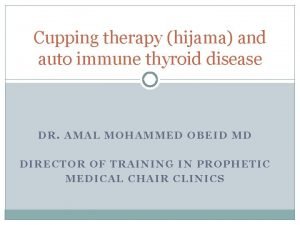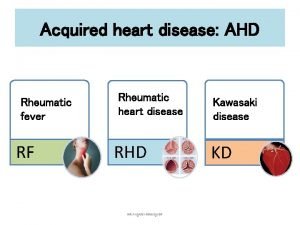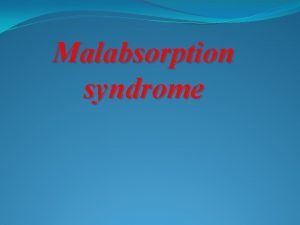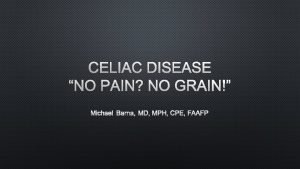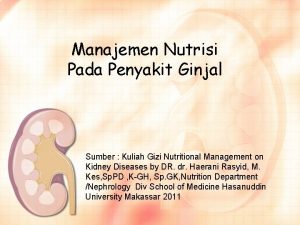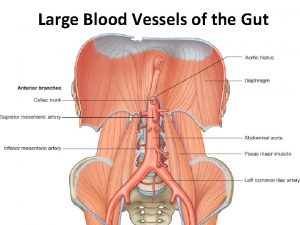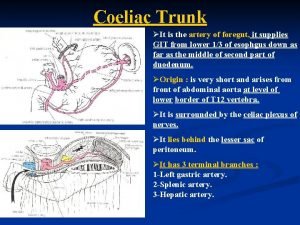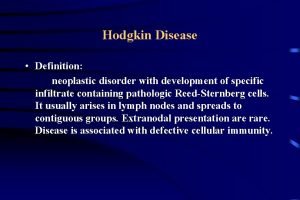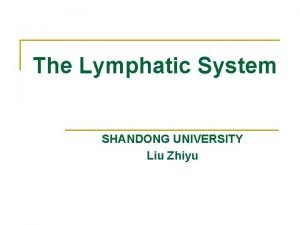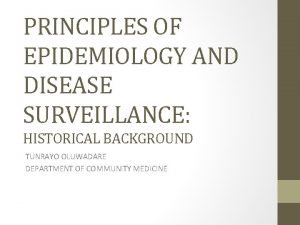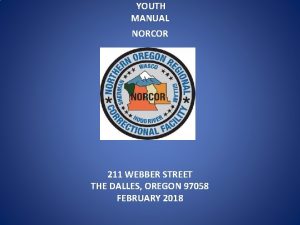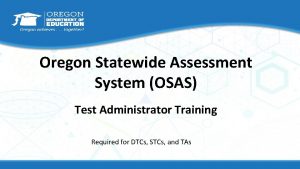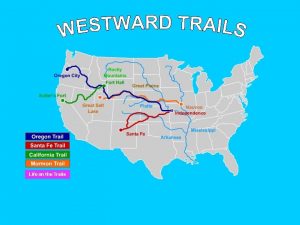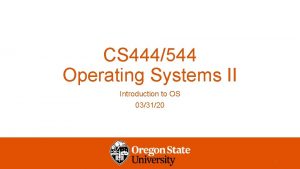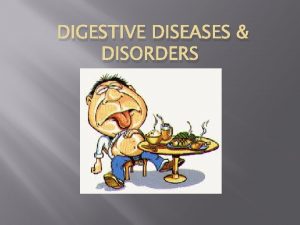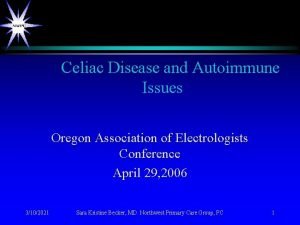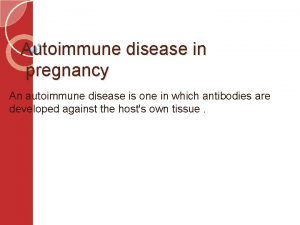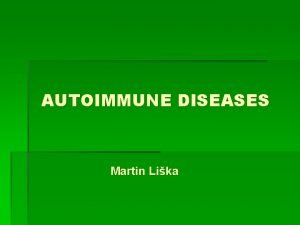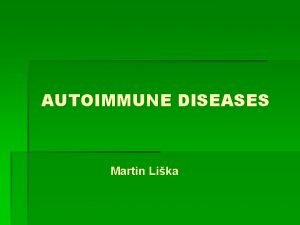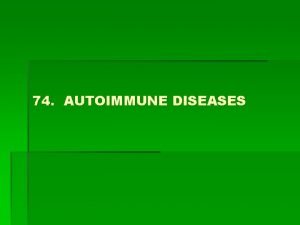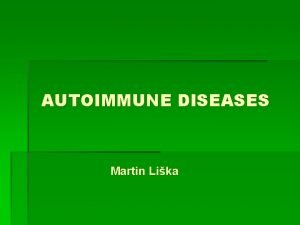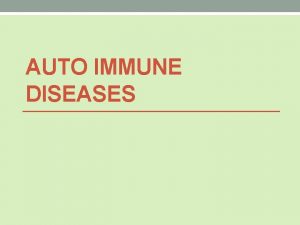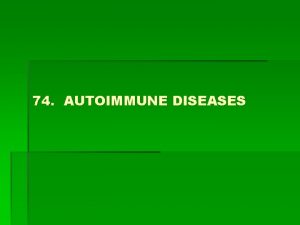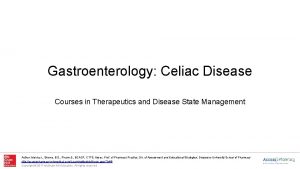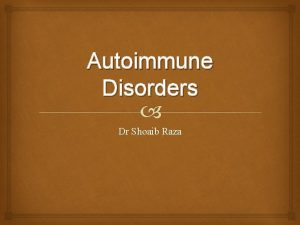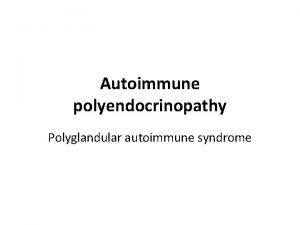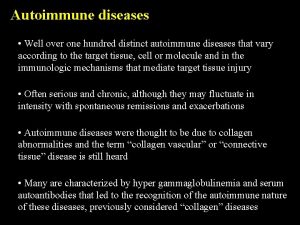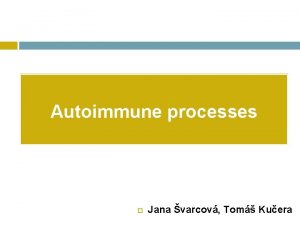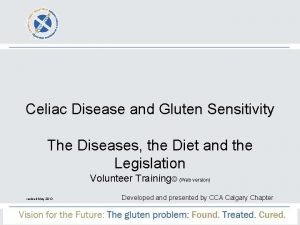Celiac Disease and Autoimmune Issues Oregon Association of







































































- Slides: 71

Celiac Disease and Autoimmune Issues Oregon Association of Electrologists Conference April 29, 2006 9/18/2020 Sara Kristine Becker, MD Northwest Primary Care Group, PC 1

What is Celiac Disease • Celiac disease is a disorder that causes problems in your intestines when you eat gluten, which is in wheat, rye, barley and oats. Gluten is like a poison to people with celiac disease. 9/18/2020 Sara Kristine Becker, MD Northwest Primary Care Group, PC 2

What is Celiac Disease • • Celiac disease used to be called Sprue. There is also illness called Tropical Sprue which is not related. 9/18/2020 Sara Kristine Becker, MD Northwest Primary Care Group, PC 3

What is Celiac Disease • Gluten damages the intestines. This damage keeps your body from taking in many of the nutrients in the food you eat. These include vitamins, calcium, protein, carbohydrates, fats and other important nutrients. Your body can't work well without these nutrients. 9/18/2020 Sara Kristine Becker, MD Northwest Primary Care Group, PC 4

Diseases Associated with Celiac Disease 9/18/2020 Sara Kristine Becker, MD Northwest Primary Care Group, PC 5

How Celiac Disease Causes Symptoms • • • The damage to the small bowel causes Malabsorbtion of nutrients causing failure to thrive Complex anemia from inability to absorb iron, folic acid, and B 12 Severe damage can prevent absorbtion of fat soluble vitamins A, D, E , and K Decreased absorbtion of zinc 9/18/2020 Sara Kristine Becker, MD Northwest Primary Care Group, PC 6

How Common is Celiac Disease • Celiac disease runs in the family. You inherited the tendency to get this disease from your parents. If 1 member of your family has celiac disease, about 1 out of 10 other members of your family is likely to have it. You may have this tendency for a while without getting sick. Then something like severe stress, physical injury, infection, childbirth or surgery can "turn on" your celiac disease. 9/18/2020 Sara Kristine Becker, MD Northwest Primary Care Group, PC 7

How Common is Celiac Disease • • • The general incidence is 2. 5 to 7. 5 per thousand people More common in women then men May be the most predetermined condtion in Humans (Hill, 2003, NIH, 2004) 9/18/2020 Sara Kristine Becker, MD Northwest Primary Care Group, PC 8

How Common is Celiac Disease • According to The University of Maryland School of Medicine Center for Celiac Research, one in 133 people is considered to be gluten intolerant and more than 1. 5 million Americans are estimated to suffer from celiac disease. 9/18/2020 Sara Kristine Becker, MD Northwest Primary Care Group, PC 9

How Common is Celiac Disease 9/18/2020 Sara Kristine Becker, MD Northwest Primary Care Group, PC 10

Genetics • No one is sure why celiac disease happens, but it appears to run in families. You have a 5 -10% chance of getting celiac disease if someone in your family has it. It's common in people from the northern European countries and the United States. How common? We think that about one in every 133 people has celiac disease in the United States. Over 50% who have celiac disease do not know it. If all these people were diagnosed, celiac disease would be more common than Type 1 diabetes. Fortunately, awareness is growing about the problem, and there are better ways of testing people for it. 9/18/2020 Sara Kristine Becker, MD Northwest Primary Care Group, PC 11

Genetics • Celiac disease -- also known as celiac sprue and GLUTENsensitive enteropathy -- is a prevalent (~1: 100) food hypersensitivity disorder caused by an inflammatory response to wheat gluten and similar proteins of barley and rye. [1] The resulting intestinal inflammation often causes symptoms related to malabsorption, but in many patients extra-intestinal symptoms dominate, and in others the disease is clinically silent. Genes encoding HLA-DQ 2 and HLA-DQ 8 molecules are the single most important predisposing genetic factor; however, although these polymorphisms are necessary, they are not sufficient for disease development. 9/18/2020 Sara Kristine Becker, MD Northwest Primary Care Group, PC 12

Genetics • • HLA-DQ 2 and HLA-DQ 8 predispose to disease development by preferential presentation to mucosal CD 4+ T cells of proline-rich gluten peptides that have undergone deamidation by the enzyme tissue transglutaminase (Transglutaminase 2; TG 2). Fewer details are known about the effector mechanisms that lead to the development of the typical celiac lesion -- villous atrophy, crypt hyperplasia and infiltration of inflammatory cells (Figure 1) -- but, once activated, gluten-reactive CD 4+ T cells produce cytokines and are likely to control the inflammatory reactions that produce the celiac lesion. This notion is based on the nature of the HLA association and the unique presentation of gluten antigens to T cells by HLA-DQ 2 or HLA-DQ 8 in the intestine. Recent advances have improved our understanding of the molecular basis for this disorder, [2] and new targets for rational therapy have been identified. This paper reviews concepts for new treatments and their current status. 9/18/2020 Sara Kristine Becker, MD Northwest Primary Care Group, PC 13

Genetics • The small-intestinal lesion in patients with celiac disease. Factors that contribute to the development of celiac disease and that can be targeted for new therapies are depicted. Proline-rich fragments of gluten that are resistant to processing by luminal and brush-border enzymes survive digestion[5] and can be transported across the mucosal epithelium as polypeptides. CD 4+ T cells in the lamina propria recognize predominantly deamidated gluten peptides[37] in the context of HLA-DQ 2 or HLA-DQ 8 molecules on the cell surface of antigen-presenting cells (APCs). [38] The deamidation of gluten peptides is mediated by tissue transglutaminase (TG 2). [39 -41] The glutenreactive CD 4+ T cells produce interferon (IFN)-γ on activation. [27] IFN-γ is also produced by T cells in the epithelium. [42] Interleukin (IL)-15, produced by either mononuclear cells in the lamina propria or by enterocytes, [30, 31] stimulates T cells to migrate to the epithelium and facilitate killing of enterocytes by upregulated expression of MIC by enterocytes and NKG 2 D by intraepithelial T cells. [29, 32] IL-15 production is stimulated by gluten. [28, 29] Gluten can also induce production of the intestinal peptide zonulin, which acts on tight junctions and increases epithelial permeability. [43] Adapted with permission from[2] ©(2002) Macmillan Publishers Ltd. 9/18/2020 Sara Kristine Becker, MD Northwest Primary Care Group, PC 14

GI Symptoms • • Abdominal bloating and pain Diarrhea Constipation Nausea and Vomiting 9/18/2020 Sara Kristine Becker, MD Northwest Primary Care Group, PC 16

GI Symptoms • • • Classic Symptoms are rare. Onset is variable which leads to delays in diagnosis Most have symptoms for over a year before diagnosis Presentation may be a infant who does well but then develops irritability with pot belly, loose bulky stools, weight loss, or failure to thrive after introduction of ceral May be less dramatic in older children 9/18/2020 Sara Kristine Becker, MD Northwest Primary Care Group, PC 17

Clinical Presentation In Youth • • • Celiac disease can cause different problems at different times: An infant with celiac disease may have abdominal pain and diarrhea (even bloody diarrhea), and may fail to grow and gain weight. A young child may have abdominal pain with nausea and lack of appetite, anemia (not enough iron in the blood), mouth sores and allergic dermatitis (skin rash). A child could be irritable, fretful, emotionally withdrawn or excessively dependent. In later stages, a child may become malnourished, with or without vomiting and diarrhea. This would cause the child to have a large tummy, thin thigh muscles and flat buttocks. Teenagers may hit puberty late and be short. Celiac disease might cause some hair loss (a condition called alopecia areata). 9/18/2020 Sara Kristine Becker, MD Northwest Primary Care Group, PC 18

Clinical Presentation In Youth • Some common symptoms of celiac disease are diarrhea, decreased appetite, stomachache and bloating, poor growth, and weight loss. Many kids are diagnosed with the problem between 6 months and 2 years of age. It makes sense because, at this time, kids are getting their first taste of gluten in foods. For some people, the problems occur gradually and the symptoms may be terrible one week and not as bad the next. Because of this, some people aren't diagnosed with the celiac disease until they are older. 9/18/2020 Sara Kristine Becker, MD Northwest Primary Care Group, PC 19

Celiac Disease in Adults • Adults who begin to be ill with celiac disease might have a general feeling of poor health, with fatigue, irritability and depression, even if they have few intestinal problems. One serious illness that often occurs is osteoporosis (loss of calcium from the bones). A symptom of osteoporosis may be night-time bone pain. About 5% of adults with celiac disease have anemia. Lactose intolerance (problem with foods like milk) is common in patients of all ages with celiac disease. It usually disappears when they follow a gluten-free diet. 9/18/2020 Sara Kristine Becker, MD Northwest Primary Care Group, PC 20

Diagnosis of Celiac Disease • New blood tests can help your doctor diagnose this disease. It's necessary to have these blood tests before you start a gluten free-diet. If you have dermatitis herpetiformis (an itchy, blistery skin problem), you have celiac disease. The diagnosis can be confirmed with a biopsy (taking a piece of tissue using a thin tube that is put into your intestines). The best confirmation, though, is if your symptoms go away when you follow a strict gluten-free diet. 9/18/2020 Sara Kristine Becker, MD Northwest Primary Care Group, PC 21

Diagnosis of Celiac Disease • If the screening tests show a person might have celiac disease, the next stop is usually a gastroenterologist, a doctor who specializes in digestive problems. This specialist may decide to take a sample of the person's small intestine to look at under the microscope. This small sample is called a biopsy. If a biopsy is done, the doctor will give the person some special medicine to keep him or her comfortable during the procedure. 9/18/2020 Sara Kristine Becker, MD Northwest Primary Care Group, PC 22

Diagnosis of Celiac Disease • Someone who has a lot of stomachaches, diarrhea, weight loss, or any of the other symptoms mentioned above should talk to the doctor. It may or may not be celiac disease, but a doctor can help sort this out. The doctor will usually order a screening blood test. 9/18/2020 Sara Kristine Becker, MD Northwest Primary Care Group, PC 23

Diagnosis • The North American Society of Pediatric Gastroenterology, Hepatology, and Nutrition (NASPGHN) (2004) recommends that primary care providers consider celiac disease early in children with a combination of persistent diarrhea and poor weight gain, weight loss or failure to thrive. Children with recurrent gastrointestinal symptoms, including abdominal pain, anorexia, constipation, vomiting or other global symptoms found in celiac disease 9/18/2020 Sara Kristine Becker, MD Northwest Primary Care Group, PC 24

Diagnosis • all children who are first degree relatives of an individual with confirmed celiac disease, have type 1 diabetes, Down syndrome, Turner syndrome, Williams syndrome, selective Ig. A deficiency or auto immune thyroiditis should be screened even if they are without gastrointestinal symptoms (NASPGHN, 2004). 9/18/2020 Sara Kristine Becker, MD Northwest Primary Care Group, PC 25

Diagnosis • Although small bowel biopsy to determine histological changes in the mucosa is the definitive diagnostic test for celiac disease, there are screening tests to help determine those children with high probability of the disease from those with low probability. 9/18/2020 Sara Kristine Becker, MD Northwest Primary Care Group, PC 26

Diagnosis • • • The currently recommended screening test is a measurement of Ig. A antibody to human recombinant tissue trans glutaminase (t. TG Ig. A) (NASPGHN, 2004). The tissue transglutaminase antibody test (t. TG) has replaced the anti-gliadin (GAG Ig. A and AGA Ig. G) and the anti-endomysium (EMA Ig. A) as the screening test of choice because of its accuracy. Most physicians do not know about this test Name is difficult to remember Expensive to do test 9/18/2020 Sara Kristine Becker, MD Northwest Primary Care Group, PC 27

Diagnosis • The Ig. A endomysial antibody immunofluorescence (EMA) test is also recommended as an equivalent screening test by the National Institute of Health (2004). 9/18/2020 Sara Kristine Becker, MD Northwest Primary Care Group, PC 28

Diagnosis • • measurement of quantitative serum Ig. A should be taken concurrently. If the child has normal Ig. A serum levels and an elevated Ig. A antibody to human recombinant tissue transglutaminase an intestinal biopsy should be scheduled to confirm the diagnosis and determine the level of involvement in the small intestine. Intestinal biopsy should also be done in children with negative serological tests but with failure to thrive, chronic diarrhea, or a diagnosis with high incidence of celiac disease (NASPGHN, 2004). 9/18/2020 Sara Kristine Becker, MD Northwest Primary Care Group, PC 29

Diagnosis • positive serology test and a negative small bowel biopsy may represent a false positive serology test or milder disease without current changes in the small bowel (latent celiac disease). 9/18/2020 Sara Kristine Becker, MD Northwest Primary Care Group, PC 30

Diagnosis • A positive serology test that reverts to negative after compliance with a gluten free diet is considered supportive evidence 9/18/2020 Sara Kristine Becker, MD Northwest Primary Care Group, PC 31

Diagnosis • In situations where the diagnosis is uncertain in a symptomatic child, HLA typing can be done, repeat small bowel biopsy may be scheduled, or a trial on a gluten free diet (GFD) can be instituted. 9/18/2020 Sara Kristine Becker, MD Northwest Primary Care Group, PC 32

Diagnosis • • Dermatitis Herpetiformis Diagnostic of Celiac Disease 9/18/2020 Sara Kristine Becker, MD Northwest Primary Care Group, PC 33

Barriers to Diagnosis • • Variability of symptoms especially at different ages Lack of education in public Lack of education in physicians Definitive test is not available No drug treatment Possible necessity of invasive procedure (small bowel biopsy to diagnoses) Definative test is gluten free diet—difficult to each and to follow in patients who are not willing to learn about it. 9/18/2020 Sara Kristine Becker, MD Northwest Primary Care Group, PC 34

Illness Due to Malnutrition • • Low dental enamel Osteoporosis (40% decreased bone density) Short Stature Delayed Puberty Arthritis Hair loss Infertility Recurrent spontaneous abortion 9/18/2020 Sara Kristine Becker, MD Northwest Primary Care Group, PC 35

Autoimmune Disease • Growing recognition that Celiac Disease is really a multi-system autoimmune disorder with many associated conditions 9/18/2020 Sara Kristine Becker, MD Northwest Primary Care Group, PC 36

Autoimmune Disease • • • Distinct Neurological component that includes ataxia, epilepsy, neuropathies Dementia Headaches Learning Disorders Developmental Delay in children Hypotonia in children 9/18/2020 Sara Kristine Becker, MD Northwest Primary Care Group, PC 37

Autoimmune Disease • • Distinct Neurological component that includes ataxia, epilepsy, neuropathies Gluten ataxia (balance problems) may be only manifestation of celiac disease. May have antibodies to perkinje cells of cerebellum (Friedrich’s Ataxia Group, UK, 2001) 9/18/2020 Sara Kristine Becker, MD Northwest Primary Care Group, PC 38

Autoimmune Disease • • Intestinal Lymphoma Intestinal carcinoma 9/18/2020 Sara Kristine Becker, MD Northwest Primary Care Group, PC 39

Autoimmune Disease • • • Autoimmune Thyroid Disease Dermatitis Herpetiformis Type 1 Diabetes Mellitus (1 in 12) Rheumatoid Arthritis Hypoparathyroidisma Sjogrens Disease IGA deficiency IGA nephropathy (kidney disease) Downs Syndrome Collagen Vascular Disorders (Lupus, MCVD) 9/18/2020 Sara Kristine Becker, MD Northwest Primary Care Group, PC 40

Autoimmune Disease • • The autoimmune reaction to the toxic protein fraction of the gluten is variable with some individuals having more damage than others to the bowel The reaction attacks the villi of the small intestine 9/18/2020 Sara Kristine Becker, MD Northwest Primary Care Group, PC 41

Treatment • • • The only treatment currently available for celiac disease is strict adherence to a gluten free diet Even small amounts of gluten regularly can result in villi damage. The National Food Authority defines glutenfree foods as food with no gluten and foods with less than 200 ppm as low gluten (NASPGHN, 2004). 9/18/2020 Sara Kristine Becker, MD Northwest Primary Care Group, PC 42

Treatment • • Gluten detection techniques are not always accurate and there is lack of solid scientific evidence for a threshold of gluten consumption that causes harm (NASPGHN, 2004). The American Dietetic Association has published guidelines for dietary treatment of celiac disease that are supported and used by most professionals treating children with celiac disease (American Dietetic Association, 2002). 9/18/2020 Sara Kristine Becker, MD Northwest Primary Care Group, PC 43

Treatment • Children who adhere to a GFD generally have resolution of their gastrointestinal symptoms, regain weight and stature if diagnosed early, regain normal amounts of red blood cells, and have improvement in their sense of physical and psychological well being (NASPGHN, 2004). 9/18/2020 Sara Kristine Becker, MD Northwest Primary Care Group, PC 44

Treatment • • Cross contamination of foods can occur via cooking or eating utensils so many families resort to a GFD for the entire household. Parents and children trying to maintain a GFD must learn to read all food labels for ingredients containing gluten, such as malt flavoring, food starches, and additives for bulk such as used in sausages or hot dogs 9/18/2020 Sara Kristine Becker, MD Northwest Primary Care Group, PC 45

Treatment • Medications can also contain gluten as a binding agent, and even some lipsticks have been found to have gluten. 9/18/2020 Sara Kristine Becker, MD Northwest Primary Care Group, PC 46

Treatment • All families with the diagnosis of celiac disease should meet with a dietitian to learn about reading food labels, common food additives to avoid, and use of rice, soy, corn, or potato flour for cooking in the home. 9/18/2020 Sara Kristine Becker, MD Northwest Primary Care Group, PC 47

Treatment • • Adolescents and children need to be educated about the foods they should avoid when eating outside the home. This can be particularly difficult for adolescents who want to conform to their peer group eating habits. Parents and providers can help children identify common foods in restaurants that are gluten free or even call ahead to restaurants to talk with the food preparers to identify food choices that are acceptable so adolescents do not need to do this in front of their peers. 9/18/2020 Sara Kristine Becker, MD Northwest Primary Care Group, PC 48

Treatment • • Referring families to a celiac support group is an excellent way of providing information regarding the condition and on maintaining a GFD. The internet also provides access to valuable information from professional organizations developed to help support individuals and families with celiac disease and commercial companies supplying gluten free foods and recipes 9/18/2020 Sara Kristine Becker, MD Northwest Primary Care Group, PC 49

Treatment of Celiac Disease • Celiac disease is serious. Fortunately you can control celiac disease just by not eating any gluten. By following the right diet, you can reverse the damage caused by celiac disease and you'll feel better. But if you "cheat" on your diet, the damage will come back, even if you don't feel sick right away. 9/18/2020 Sara Kristine Becker, MD Northwest Primary Care Group, PC 50

Treatment of Celiac Disease • You'll have to explain your problem and the gluten -free diet to your family members and ask for their support and help. It will take time for you and your family to learn how to avoid gluten in your diet. You can contact one of the celiac support groups listed in the right column of this handout. These groups are excellent sources of information and advice. They'll help you find gluten-free foods and good recipes, and give you tips for successfully living with celiac disease. 9/18/2020 Sara Kristine Becker, MD Northwest Primary Care Group, PC 51

Treatment of Celiac Disease • Celiac disease is treated by not eating gluten. This can be difficult because gluten is in many foods, but a dietitian can help adjust a person's diet to cut out gluten. It is important not to start a gluten-free diet unless you are truly diagnosed with celiac disease. Following a gluten-free diet allows the small intestine to heal. But that doesn't mean the person can start eating gluten again. For someone with celiac disease, gluten will always irritate their intestines and, if this happens, the diarrhea, stomachaches, and other problems will return. 9/18/2020 Sara Kristine Becker, MD Northwest Primary Care Group, PC 52

Treatment of Celiac Disease • If you're diagnosed with celiac disease, it can be a challenge to learn which foods contain gluten. You may not be able to remember them all, but you can keep a list with you, and ask about menu items at restaurants before digging in. Before you know it, you'll be a pro at knowing which foods are safe and which are not. 9/18/2020 Sara Kristine Becker, MD Northwest Primary Care Group, PC 53

Treatment of Celiac Disease • • • Here's a quick quiz: Which of these foods contain gluten? pizza fried chicken pasta If you said all three, you're right! Pizza was the easiest choice because you know the crust is bread. But did you know that battered foods like fried chicken and even some French fries contain gluten? Pasta also contains gluten because it is made from wheat. Luckily, you can make or buy gluten-free pizza crust, make fried chicken with a gluten-free batter, and find gluten-free pasta and French fries. In fact, nearly all of the foods we eat can be made gluten-free. 9/18/2020 Sara Kristine Becker, MD Northwest Primary Care Group, PC 54

Treatment of Celiac Disease • In addition to foods that contain gluten, you'll need to watch out for foods that may have been contaminated with gluten. That means a food that doesn't contain gluten as an ingredient, but came into contact with gluten-containing foods. This is most likely to occur at home in your own kitchen. For instance, wheat bread crumbs in the toaster, the butter, or peanut butter 9/18/2020 Sara Kristine Becker, MD Northwest Primary Care Group, PC 55

Treatment of Celiac Disease • If you have celiac disease you will need your own toaster and you should also have separate spreads and condiments to avoid this cross-contamination. Some foods are contaminated during processing. This is often what happens to oats. Oats do not contain gluten, but many doctors and dietitians recommend avoiding them because they are milled or processed in plants with wheat, rye, or barely and therefore become contaminated. . 9/18/2020 Sara Kristine Becker, MD Northwest Primary Care Group, PC 56

Treatment of Celiac Disease • • • The best approach is to read labels, but here a few foods to steer clear of until you can verify that they are gluten-free: packaged rice mixes lunch meats sausages instant cocoa canned soups 9/18/2020 Sara Kristine Becker, MD Northwest Primary Care Group, PC 57

Treatment of Celiac Disease • Spelt 9/18/2020 Sara Kristine Becker, MD Northwest Primary Care Group, PC 58

Treatment of Celiac Disease 9/18/2020 Sara Kristine Becker, MD Northwest Primary Care Group, PC 59

Treatment of Celiac Disease • • All Patients With Osteoporosis May Benefit From Screening for Celiac Disease 9/18/2020 Sara Kristine Becker, MD Northwest Primary Care Group, PC 60

Long Term Effects • • Natural history of untreated, and partially treated celiac disease is unknown (Hill, 2003) Stunting of growth Profound effect on school performance and quality of life (neurologic damage in children may not be fully reversible) Unknown if untreated diseases causes increased risk of GI malignancies, or other diseas 9/18/2020 Sara Kristine Becker, MD Northwest Primary Care Group, PC 61

Restaurants Outback • Grolla Restaurant and Wine Bar, 2930 NE Killingsworth St. Portland, OR 503 -493 -9521 • 9/18/2020 Sara Kristine Becker, MD Northwest Primary Care Group, PC 62

Grain Supplies 9/18/2020 Sara Kristine Becker, MD Northwest Primary Care Group, PC 63

Grain Supplies • Bob’s Red Mill Natural Foods expands Gluten Free Line with new mixes Bob's Red Mill has added two new gluten-free products – GF Brownie Mix and GF Pancake Mix – to its successful Gluten Free line. Consumers with celiac disease, wheat allergies and wheat intolerances can now choose from a total of seven signature Gluten Free products as well as more than 40 naturally gluten-free items – all backed by testing and identified by the symbol shown above 9/18/2020 Sara Kristine Becker, MD Northwest Primary Care Group, PC 64

Grain Supplies • Bob’s Red Mill stone grinds flours in a dedicated room for the production of its gluten-free line and performs batch testing before processing and after packaging. The company adheres to the Codex Alimentarius standard – the international glutenfree food standard for manufacturers. While the current Codex gluten-free standard specifies a gluten limit of 200 parts per million (ppm), Bob’s Red Mill’s gluten-free products consistently fall below 20 ppm. 9/18/2020 Sara Kristine Becker, MD Northwest Primary Care Group, PC 65

Grain Supplies • • Organic Buckwheat Kernels (Roasted-Kasha)Organic Creamy Buckwheat Cereal. Almond Meal/Flour. Amaranth Grain. Arrowroot Starch. Baking Powder. Baking Soda. Black Bean Flour. Brown Rice Flour. Buckwheat Groats Organic. Cornstarch. Creamy Brown Rice Farina. Ener-G Foods Crackers. Ener-G Foods Egg Replacer. Ener-G Foods Granola Bars. Ener-G Foods Pound Cake. Ener-G Foods White Rice Lasagna. Ener-G Foods White Rice Macaroni. Ener-G Foods White Rice Spaghetti. Ener-G Sesame Pretzel Rings. Fava Bean Flour. Flaxseed Meal (Golden)Garbanzo Bean Flour. Gluten Free All Purpose Baking Flour. Gluten Free Brownie Mix. Gluten Free Chocolate Cake Mix. Gluten Free Chocolate Chip Cookie Mix. Gluten Free Diet. Gluten Free Garbanzo and Fava Flour. Gluten Free Homemade Wonderful Bread Mix. Gluten Free Mighty Tasty Hot Cereal. Gluten Free Pancake Mix. Gluten Free Sweet White Sorghum Flour. Gluten-Free 101 Gluten-Free Gourmet Makes Desserts. Gluten-Free Starter Kit. Golden Flaxseed, Organic. Green Pea Flour. Guar Gum. Hazelnut Meal/Flour. Hulled Millet Flour. Millet Grits/Meal. Organic Buckwheat Flour. Organic Coconut Flour. Organic Quinoa Flour. Pamela's Chunky Chocolate Chip Cookies. Pamela's Ginger Cookies. Pamela's Peanut Butter Cookies. Pamela's Shortbread Swirl Cookies. Potato Flour. Potato Starch. Quinoa Organic Grain. Rice Bran. Sweet White Rice Flour. Tapioca Flour. Teff (Tef, T'ef) Whole Grain. TSPTVP® (Textured Vegetable Protein)Wheat Free Biscuit & Baking Mix. White Bean Flour. White Rice Flour. Xanthan Gum. Yeast, Active Dry. Yeast, Nutritional T 6635 • Bob's Red Mill Natural Foods • 5209 SE International Way • Milwaukie, OR 97222 Business Hours 8 am – 5 pm Monday-Friday (800) 349 -2173 FAX (503) 653 -1339 9/18/2020 Sara Kristine Becker, MD Northwest Primary Care Group, PC 66

Resources • • In the following cookbooks, the author, who has celiac disease herself, shares what she has learned about a gluten-free diet. Bette Hagman is the author. The publisher is Henry Holt and Co. The Gluten-Free Gourmet: Living Well Without Wheat More From the Gluten-Free Gourmet The Gluten-Bible Waiter…. is there Wheat in my Soup? The Gluten-Free Gourmet Cooks Fast and Healthy This book is a general guide to living gluten-free: Against the Grain: The Slightly Eccentric Guide to Living Well Without Gluten or Wheat, written by Jax Peters Lowell and published by Henry Holt and Co. 9/18/2020 Sara Kristine Becker, MD Northwest Primary Care Group, PC 67

Organizations • • Celiac Disease Foundation http: //www. celiac. org 13251 Ventura Blvd. , #1 Studio City, CA 91604 818 -990 -2354 American Celiac Society-Dietary Support Coalition 58 Musano Court West Orange, NJ 07052 973 -325 -8837 9/18/2020 Sara Kristine Becker, MD Northwest Primary Care Group, PC 68

Organizations • • Celiac Sprue Association http: //www. csaceliacs. org 1 -877 -CSA-4 CSA celiacs@csaceliacs. org Gluten Intolerance Group of North America 15110 10 th Ave. SW, Suite A Seattle, WA 98166 -1820 206 -246 -6652 9/18/2020 Sara Kristine Becker, MD Northwest Primary Care Group, PC 69

References • Detecting Celiac Disease in Your Patients (American Family Physician March 1, 1998, http: //www. aafp. org/afp/980301 ap/pruessn. html) 9/18/2020 Sara Kristine Becker, MD Northwest Primary Care Group, PC 70

References 9/18/2020 Sara Kristine Becker, MD Northwest Primary Care Group, PC 71

References 9/18/2020 Sara Kristine Becker, MD Northwest Primary Care Group, PC 72
 Thyroid hijama points
Thyroid hijama points Ahd heart
Ahd heart Dr tufan kutlu
Dr tufan kutlu Malabsorption syndrome
Malabsorption syndrome Celiac disease in france
Celiac disease in france Celiac disease pes statement
Celiac disease pes statement Marsh classification of celiac disease
Marsh classification of celiac disease Celiac disease pes statement
Celiac disease pes statement Pes statement for celiac disease
Pes statement for celiac disease Celiac disease colville
Celiac disease colville Autoimmune diet
Autoimmune diet Is crohns autoimmune
Is crohns autoimmune Bharathi viswanathan
Bharathi viswanathan Oregon city attorneys association
Oregon city attorneys association Association of oregon recyclers
Association of oregon recyclers Priotization matrix
Priotization matrix Oregon association of school business officials
Oregon association of school business officials Superior mesenteric artery origin
Superior mesenteric artery origin Disease management association of america
Disease management association of america Fascia thoracolumbalis
Fascia thoracolumbalis Common hepatic artery
Common hepatic artery Branches of coeliac trunk
Branches of coeliac trunk Acid secretion
Acid secretion Median cubital vein
Median cubital vein Celiac 504 plan
Celiac 504 plan Willis
Willis Celiac disesae
Celiac disesae Nasopharynx lymph node drainage
Nasopharynx lymph node drainage Celiac beri beri
Celiac beri beri Celiac beri beri
Celiac beri beri Prometheus celiac serology
Prometheus celiac serology Oregon early learning and kindergarten guidelines
Oregon early learning and kindergarten guidelines Oregon housing and community services
Oregon housing and community services Ethical media issues
Ethical media issues E commerce security and fraud issues and protections
E commerce security and fraud issues and protections Professional issues in information security
Professional issues in information security Norcor the dalles oregon
Norcor the dalles oregon The oregon treaty of 1846
The oregon treaty of 1846 Tractor safety course oregon
Tractor safety course oregon Oregon trail platforms
Oregon trail platforms Fun facts about oregon trail
Fun facts about oregon trail Oregon trail software
Oregon trail software Mecop oregon state
Mecop oregon state Oregon country previous owner
Oregon country previous owner Motorcycle safety course oregon
Motorcycle safety course oregon Dangers on the oregon trail
Dangers on the oregon trail Work incentives network oregon
Work incentives network oregon Oregon qris
Oregon qris Oregon wic program
Oregon wic program Oregon test portal
Oregon test portal Oregon state board of nursing license
Oregon state board of nursing license Oregon spatial data library
Oregon spatial data library Oregon project independence
Oregon project independence Oregon math project
Oregon math project Oregon wastewater operator certification
Oregon wastewater operator certification Oregon department of aviation
Oregon department of aviation What four countries claimed the oregon country?
What four countries claimed the oregon country? Fort hall oregon trail
Fort hall oregon trail Honor flight portland oregon
Honor flight portland oregon Hp corvallis
Hp corvallis Team oregon erider
Team oregon erider Prism oregon state
Prism oregon state Cs 444 oregon state
Cs 444 oregon state Oregon state university wue
Oregon state university wue Oregon v rideout
Oregon v rideout Why was oregon called a “pioneer’s paradise”?
Why was oregon called a “pioneer’s paradise”? Oregon fever apush
Oregon fever apush Oregon homecare registry
Oregon homecare registry Benefits of volunteering
Benefits of volunteering Map of the 7 wonders of the ancient world
Map of the 7 wonders of the ancient world Rajneeshee oregon
Rajneeshee oregon Pwiveri
Pwiveri
